

When 145 foilers converged at the Foil Bay of Islands regatta in February, they put on a mind-blowing, magical, even unbelievable show. What makes these things and their pilots get up and go?
They choose to fly. While the rest of us mere mortals plod along at four knots, glued to the water, slogging into chunky chop, slapped by rude powerboat wakes, taking spray full in the face, the foilers are soaring. Like sailing superheroes: Zip! Zoom! Zowee! Foilers live the dream of us waterslugs: admit it, wouldn’t you like to go flying at 10, 15, 20, even 30 knots, the foils singing, an insane velocity of apparent wind whistling through your helmet? Are you ready to step up, to live on the cutting edge instead of the (sigh, yawn) ordinary sailing experience? It can happen to you.
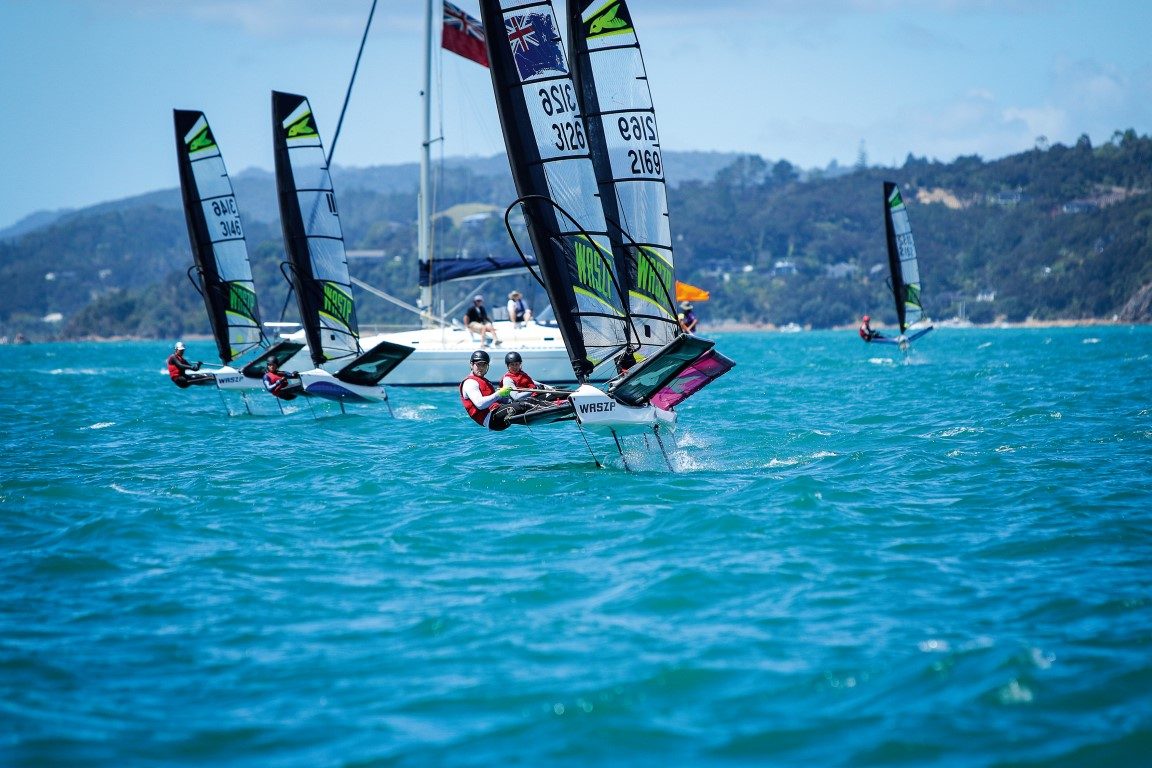
Over the past year I have seen my circle of seemingly normal sailing friends become consumed by wing-foiling. If they go without winging for more than 12 hours they slip into withdrawal – they get fidgety, they check the forecast on their phone, they look for clouds with solid breeze. When the wind is right, they jump on their boards and they’re gone, a dot on the horizon. Speaking as an aging 470 crew, I admire their dedication but find their attraction to foiling puzzling. For 20 years I was totally committed to the sport of dinghy racing, I admit it, but I never felt a tug of addiction. But foiling seems to grab people in the visceral way of surfing and snowboarding. I went to the Foil Bay of Islands 2024 event, the largest gathering of foil flyers in the Southern Hemisphere, to try to find out what it is all about.

Hosted by the Bay of Islands Yacht Club, in wraparound waterfront headquarters just a few hundred metres from the Treaty Grounds at Waitangi, the annual event is the brainchild of members Chris and Debbie Fewtrell, who, along with sons Thomas and Jacob and scads of YC helpers, invest prodigious amounts of time and energy into coercing and organising volunteers and running the regatta. It’s a sprawling undertaking: competitors launch from four venues, including the yacht club, there’s multiple racecourses, lots of squawking handheld VHFs, committee boats, safety boats and, like glitter sprinkled across the water, a herd of multicolored cats, known as regatta participants, to keep tabs on.
Because they are located at Waitangi, regatta organisers need to go with the flow. On the final day of racing, when two cruise ships dropped anchor in the middle of the bay and the parade of shoreboats to the yacht club’s shared wharf began, and a dozen tour buses jammed into the carpark next to the club, and some tourists wandered through the club (Are we at the Treaty House?), Chris Fewtrell and his team promptly moved three of the race courses out of the path of the madness, notifying competitors via a regatta management app, and the regatta went on. That’s composure under fire.
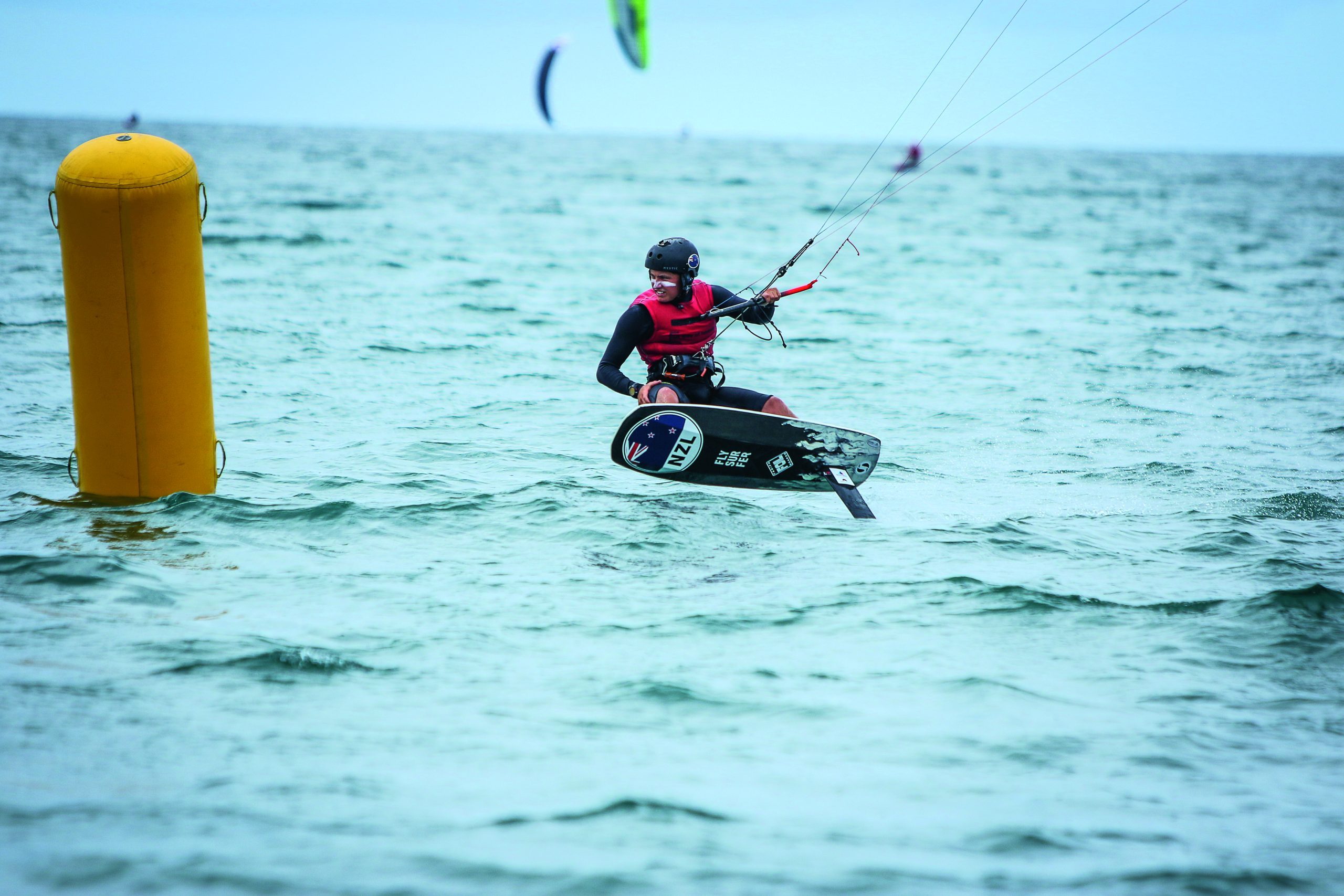
Meanwhile, I kept up my search for foilers. Who are these people? If sailors of conventional boats are Mum and Dad towing a campervan, foilers are freedom campers. They have stepped off the well-beaten track and found a faster and more fun way to sail. Foilers are recognisable by their body type: lean and lithe, with structural abs, every arm and leg muscle toned and tanned – there are no bulky rail-sitters, hunky winch-grinders, or extra ounces of fat at foiling events. The vehicles that foilers sail look simple, like watertoys for grownups, but they are in fact complex in subtle ways, a tad mysterious, and highly tunable: achieving the perfect setup pays giddy dividends in speed.
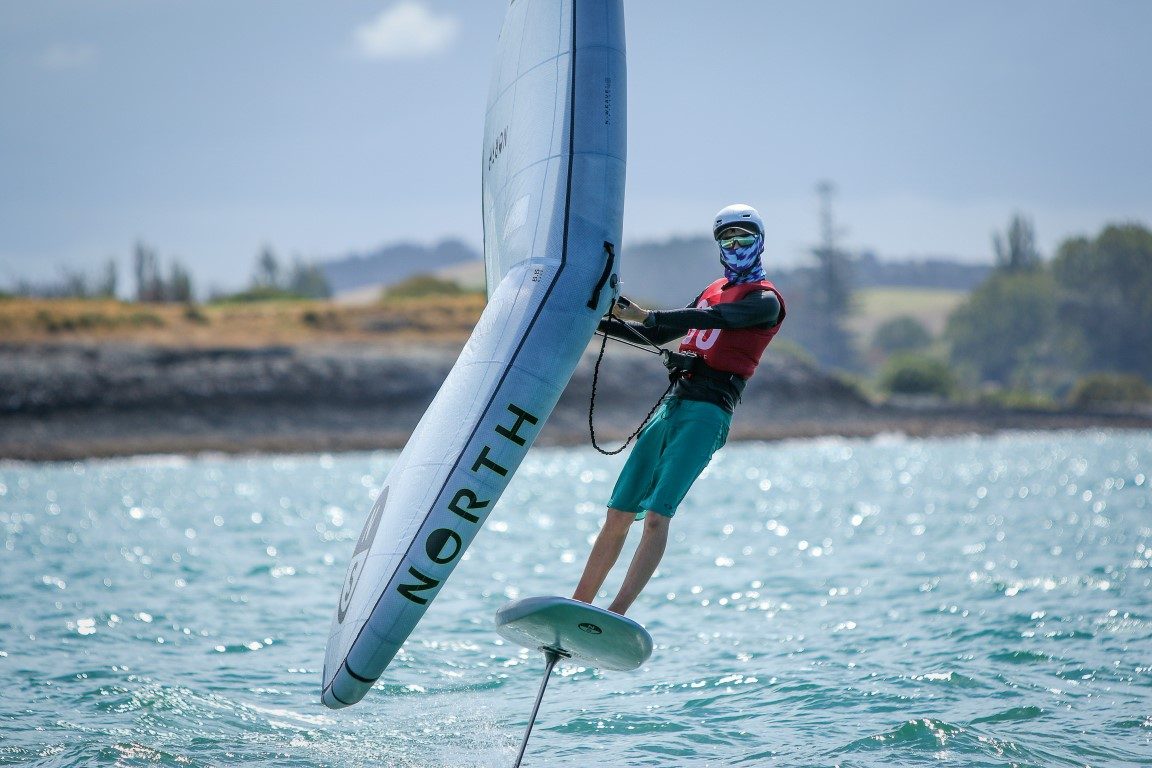
Because their vehicles are technical, the people obsessed with flying them are technical, almost nerdy. Spot a knot of foilers on the beach and they are likely comparing optimal ratios of body weight to board size/flotation, or fore-and-aft positions of the ‘mast’ (the underwater vertical strut that carries the forward and aft foils), or the size, shape, and angle of attack of the foils on the ‘fuse’ (the underwater fuselage for the foil mounts). And the sail, which foilers call a wing – the size, the aspect ratio, and who’s making the hottest one now. Foiling, you see, is a heck of a lot more challenging than turning a key or pushing a throttle. Of course, you can go foiling just for fun, and everyone does. Going fast puts a smile on your face. But right now, the foilers are here to race.
There are four classes at Foil Bay of Islands: the WASZP, Windfoil, KiteFoil, and Wingfoil (see Fast Guide to Foilers sidebar). With 80 entrants, the Wingfoil fleet is the biggest, with gold, silver, and social divisions (“light-hearted winging around an easier course”) with trophies to match. The New Zealand National Championship for the KiteFoil and Windfoil are up for grabs, too.
But how do you race a foiler? It’s not like monohulls or conventional dinghies, where you are looking for a five-degree windshift or another click on the mainsheet to inch you ahead of the competition. With foiling, everyone is angling for two things: 1) How to maximise the apparent wind, and 2) How to stay up on the foils forever.

Chasing and making apparent wind is what every foiler lives for. Look at how WASPZ skippers make and manage apparent wind on a downwind leg. When they sense the wind velocity dropping a hair and the boat slowing ever so slightly, they jam the rudder, a high-aspect carbon-fibre steak knife, and throw the boat up, up, up, stoking the apparent wind, and the boat responds instantly, going faster and faster. The moment the foils and the sail\wing are fully powered, WASPZ skippers carve smoothly down, down, keeping the speed while cutting the distance to the next mark.
Windfoilers jerk the rig to boost their apparent wind – when the wind drops, the windfoiling fleet looks like a flock of hyperactive butterflies. Wingfoilers use their arms, shoulders, and torso to pump the wing fast and violently, manufacturing shots of apparent wind, trying to pop up onto the foils. And kitefoilers, well, they have ways to manipulate their wing that rides high up in the sky. I don’t know if these ways can be explained.
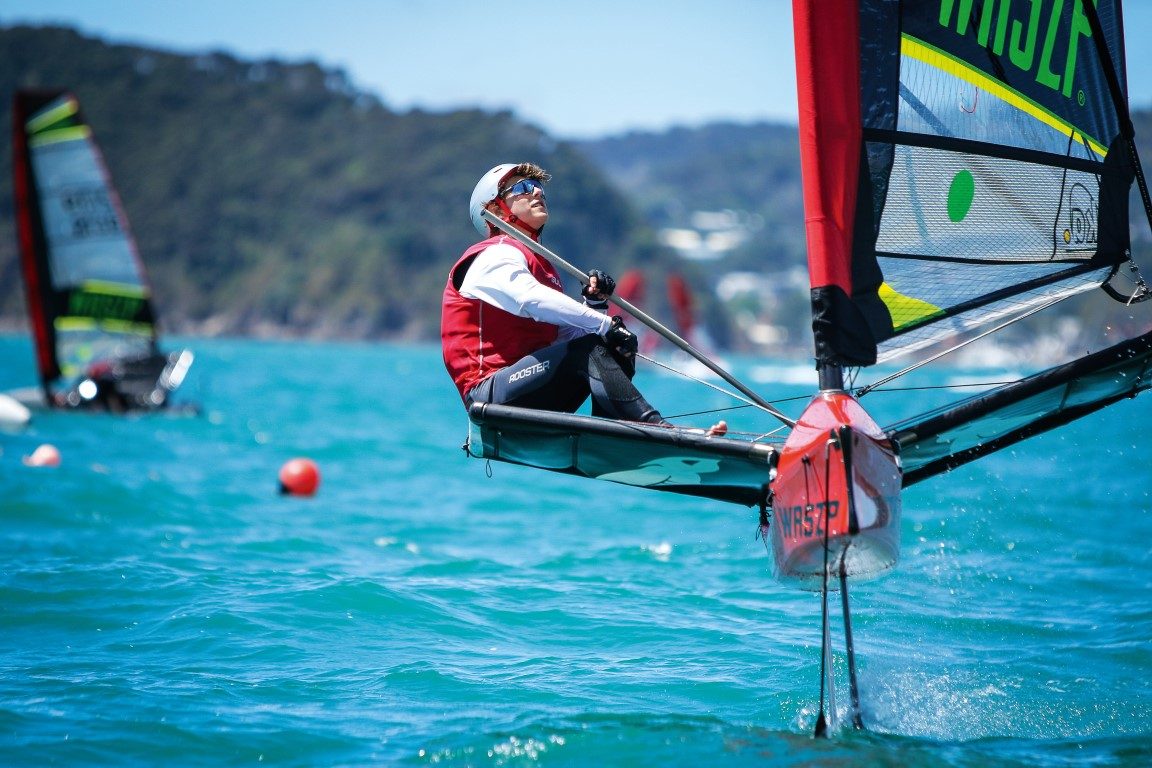
The penalty for dropping off the foil, as any watcher of America’s Cup and SailGP racing knows, is not death, but it feels like death. OK, say you’ve sailed into a hole or made a mistake with your wing or the nose to tail attitude of your board, and you’re off the foil. The competition zooms past at 10, 15, or 20 knots, gone. What now? In a WASPZ, KiteFoil, or Windfoil, you jerk, pump, and flail the wing madly to get back up, and soon you do. But on a Wingfoiler, go off the foils and your little board, which is not much bigger than the cocktail table on your sun deck, can sink and you may end up dog paddling, arranging your body, board, and wing in the right order for a go at lift-off. Then you scramble up on your knees on the board, lift the sail out of the water, pump and flail yourself up and onto the foils. Sometimes this takes a while.
Even in a steady wind, foiling is not about zooming all the time; for newbies, there is a side that’s not much fun. I watched a few races of the 40-boat wingfoil Social fleet. These sailors, who know how to wingfoil but have never raced, handled their boards and wings well on the tight reach from the starting line to the first mark. The top handful of competitors handled the gybe toward the next mark expertly, carving around the buoy, spinning their wing overhead, switching hands on the sail handles, switching their foot stance for the new gybe, all while staying on the foil. Grace and power!

But behind them, watery chaos. Some competitors suddenly ran out of breeze, their board skittered out from under their feet, and everything sank straight down. Glub, glub, glub. Other competitors nosedived, and the wing and sailor parted company with the board, thrown through the air. Yeowww! And some competitors couldn’t find the right moment to gybe, postponing the inevitable, and were carried well past the gybe buoy. Oh nooooo! Meanwhile, the top bunch of competitors had crossed the finish line.
No one was hurt, except for their pride, in the barrage of soft landings. Yep, it does take significant practice to learn how to gybe a foiling craft. As with any challenging but ultimately rewarding sport, agony comes before ecstasy. And the experts, of course, make it look too easy. The Social sailors who crashed dog paddled, arranged their pieces, lifted their wing out of the water and headed for the finish.
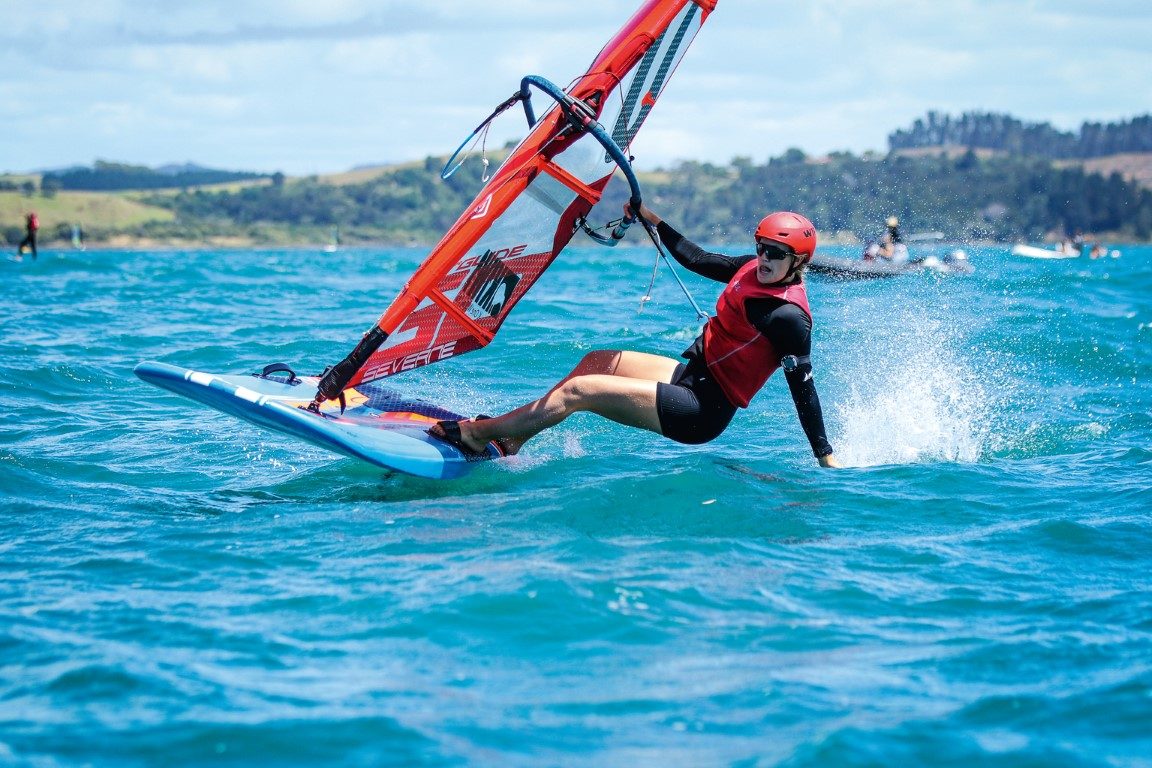
One sure thing about foiling – all the classes, the myriad ways to do it – is that the sport is constantly developing. New ideas bubble up from foilers riding big Hawaiian waves, from foilers gliding over Lake Taupo, from the Olympic Games to the European Championships, from New Zealand high school boys and girls to America’s Cup crews. It can always seem like these are early days in foiling, because everything is evolving. But foiling will always remain fast. And fun. And challenging. And addictive.
FAST GUIDE TO FOILERS
1. Tim Howse
2. Noah Malpot
3. Peter Graham
1. Hugo Wigglesworth
2. Lochy Naismith
3. Andy Robertson
IQ9M Class (9 entrants)
1 Josh Armit
2. Elijah Lieting
3. Thomas Crook
9M Silver Class (3 entrants)
1. Alex Hansen
2. Russ Evans
3. Andrey Vladimirovich Konstantinov
Silver Class (4 entrants)
1. Finn Davies
2. Sofia Curie
3. Daniella Woolridge
Open Class (8 entrants)
1. Tim Wood
2. Nick Thomas
3. Alin Misescu
IQW Class (8 entrants)
1. Veerle ten Have
2. Stella Bilger
3. Brianna Orams
IQY Class (5 entrants)
1. Jack Parr
2. Ben Rist
3. Vlad Misescu
IQJ Class (2 entrants)
1. Sol Douwes
2. Margarita Andreevna Kostantinova
1. Sean Herbert
2. Kosta Gladiadis
3. Lloyd Perratt
Silver Class (22 entrants)
1. Rowan Kensington
2. Michael Scholes
3. Andrew Mitchell
Social Class (42 entrants)
1. Mark Hursthouse
2. Tony Mackenzie
3. Chris Kennedy




